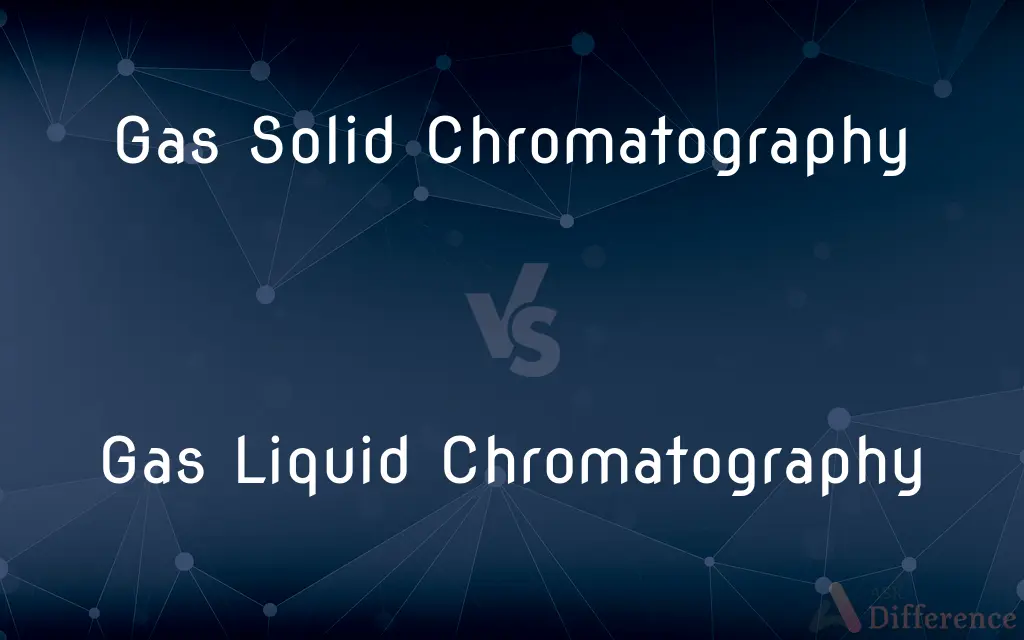Gas Solid Chromatography vs. Gas Liquid Chromatography — What's the Difference?
By Tayyaba Rehman — Published on January 12, 2024
Gas-solid chromatography (GSC) separates compounds using a solid stationary phase, while gas-liquid chromatography (GLC) uses a liquid stationary phase coated on a solid support for separation.

Difference Between Gas Solid Chromatography and Gas Liquid Chromatography
Table of Contents
ADVERTISEMENT
Key Differences
In gas-solid chromatography, the stationary phase is a solid on which the sample components adsorb differently. In gas-liquid chromatography, the stationary phase is a non-volatile liquid coated on a solid support, and separation is based on different solubilities.
GSC typically deals with gases and small molecules that do not interact chemically with the solid phase. GLC is suitable for a broader range of compounds, including larger, more complex molecules.
The separation in GSC is based on physical adsorption on the solid surface. In GLC, separation occurs due to the different degrees of partitioning between the liquid stationary phase and the mobile gas phase.
Gas-solid chromatography is often limited by the fact that stronger adsorbing components can adhere too strongly to the solid phase. Gas-liquid chromatography offers a more versatile and efficient separation, especially for complex mixtures.
GSC is simpler but less sensitive compared to GLC. GLC, with its liquid stationary phase, provides better separation efficiency and sensitivity, suitable for analytical and quantitative analyses.
ADVERTISEMENT
Comparison Chart
Stationary Phase
Solid
Liquid coated on solid support
Separation Mechanism
Adsorption on solid surface
Partitioning between liquid and gas
Suitable Compounds
Gases, small molecules
Broader range, including large molecules
Efficiency and Sensitivity
Less sensitive, simpler
Higher efficiency and sensitivity
Typical Applications
Basic gas analysis
Complex mixture analysis, quantitative work
Compare with Definitions
Gas Solid Chromatography
Separation technique based on adsorption.
In gas-solid chromatography, molecules adhere to the solid phase at different rates.
Gas Liquid Chromatography
Chromatography suitable for quantitative analysis.
GLC is commonly used in laboratories for precise quantitative measurements.
Gas Solid Chromatography
Chromatography with physical interaction.
GSC relies on the physical adsorption of gas on the solid surface.
Gas Liquid Chromatography
Separation based on solubility differences.
In gas-liquid chromatography, components distribute between the liquid and gas phases.
Gas Solid Chromatography
Analytical method for gases and small molecules.
GSC is ideal for separating and analyzing simple gas mixtures.
Gas Liquid Chromatography
High-efficiency separation method.
Gas-liquid chromatography provides detailed separation of complex mixtures.
Gas Solid Chromatography
A less complex form of gas chromatography.
Gas-solid chromatography offers a straightforward approach for basic gas analysis.
Gas Liquid Chromatography
Analytical technique for diverse compound analysis.
GLC is versatile for analyzing both small and large molecular weight compounds.
Gas Solid Chromatography
Chromatography with a solid stationary phase.
GSC was used to analyze the composition of the gas sample.
Gas Liquid Chromatography
Chromatography using a liquid stationary phase.
GLC was employed to separate complex organic compounds.
Common Curiosities
What is gas-solid chromatography?
A type of chromatography using a solid stationary phase for gas separation.
How does separation occur in GLC?
Through the differential solubility between the liquid and gas phases.
What distinguishes gas-liquid chromatography?
It uses a liquid stationary phase coated on a solid for separation.
In which fields is GSC commonly used?
Basic gas analysis and small molecule separation.
What types of samples are best for GSC?
Simple gases and small molecular weight substances.
What are the limitations of GSC?
Lower sensitivity and potential for strong adsorption.
How does GLC benefit complex mixture analysis?
It offers high separation efficiency for complex and diverse compounds.
Does GLC require special equipment?
Yes, it needs specific columns and detectors for liquid phase chromatography.
What is the primary mechanism in GSC?
Physical adsorption of gases on a solid surface.
How do temperature and pressure affect GSC?
They can influence the adsorption process and separation efficiency.
Is GLC more sensitive than GSC?
Yes, GLC provides greater sensitivity and precision.
Is GLC versatile in terms of application?
Yes, it's widely used in various fields from environmental to pharmaceutical analysis.
Can GSC analyze large organic molecules?
Generally, it's not suitable for large molecules.
Why is GLC preferred in quantitative analysis?
Due to its high precision and ability to handle complex mixtures.
Can GSC be used for liquid samples?
It's mainly used for gases and vapors, not liquids.
Share Your Discovery

Previous Comparison
Product Development vs. Market Development
Next Comparison
IMAP vs. POP3Author Spotlight
Written by
Tayyaba RehmanTayyaba Rehman is a distinguished writer, currently serving as a primary contributor to askdifference.com. As a researcher in semantics and etymology, Tayyaba's passion for the complexity of languages and their distinctions has found a perfect home on the platform. Tayyaba delves into the intricacies of language, distinguishing between commonly confused words and phrases, thereby providing clarity for readers worldwide.
















































